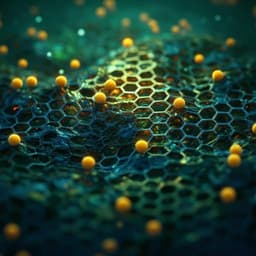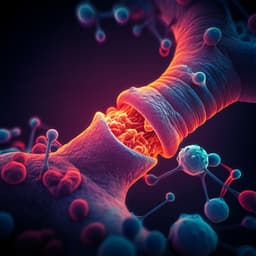
Chemistry
Emergence of a short peptide based reductase via activation of the model hydride rich cofactor
A. Chatterjee, S. Goswami, et al.
This research showcases innovative short peptide-based amyloid nanotubes that effectively bind and reduce ester substrates in water using weak hydride transfer agents, demonstrating recyclability and controlled reduction. Conducted by Ayan Chatterjee, Surashree Goswami, Raushan Kumar, Janmejay Laha, and Dibyendu Das, the findings could reshape our understanding of protometabolism on early Earth.
~3 min • Beginner • English
Introduction
Early versions of metabolism likely exploited energetically downhill electron transfer from small molecule cofactors, helping to generate proton gradients for pyrophosphate synthesis. Primitive catalysts would have been required to facilitate minimal metabolic cycles via connected redox reactions, gradually enabling biochemical complexity toward protocellular life. In modern biology, anionic low molecular weight cofactors such as NADPH/NADH are vital hydride donors in processes like glycolysis and oxidative phosphorylation, but typically require highly evolved protein binding pockets—often rich in cationic residues like arginine—to activate and position the cofactors for effective hydride transfer. A key open question is how primitive cofactors and minimal biopolymers cooperated to enable early redox chemistry prior to complex enzymes. Short peptides capable of forming cross-β amyloid phases with solvent-exposed residues have been proposed as surrogates of primitive protein folds, forming robust nanostructures featuring antiparallel β-sheets. The authors ask whether short peptide fragments could exploit electrostatic effects and hydrophobic binding sites to localize and activate rudimentary hydride donors to facilitate aqueous-phase chemical transformations otherwise disfavored. They aim to demonstrate that short amyloid-based nanotubes can colocalize weak hydride donors (NaBH4) and hydrophobic ester substrates to achieve efficient reductions in water, mimicking aspects of enzyme–cofactor activation.
Literature Review
The work builds on established roles of NADPH/NADH as hydride donors that require protein binding pockets for activity, where cationic residues (e.g., arginine) facilitate electrostatic interactions with anionic cofactors. Short peptides and amyloid assemblies have been argued to represent primitive protein folds and have previously shown robustness and catalytic potential in cross-β architectures. Prior studies reported catalytic amyloids and enzyme-mimetic functions from peptide assemblies, including non-proteinaceous hydrolases and oxidase-mimetic nanomaterials. Earlier surfactant-based systems (e.g., cationic micelles such as CTAB) enabled NaBH4-mediated ester reductions at interfaces but with modest yields. The present study situates itself at the intersection of prebiotic chemistry, peptide supramolecular chemistry, and cofactor activation, leveraging paracrystalline amyloid nanotubes with cationic and hydrophobic surfaces to localize cofactors and substrates for hydride transfer in water.
Methodology
Peptide design and assembly: The core Aβ(17–21) fragment LVFFA was modified with terminal residues to produce Ac-RLVFFAL-NH2 (ARG-16) and a supercharged variant replacing arginine with a quaternized glycine (betaine trimethyl ammonium) to yield 16BLVFFA22L (BET-16). Additional control sequences included ARG-16ARG-22 (extra Arg at position 22), ARG-16PHE-17 (scrambled hydrophobic core to FLVFA), ARG-18PHE-20 (shorter tripeptide Ac18RF20F-NH2), GLU-16 (Ac-ELVFFAL), LYS-16 (Ac-KLVFFAL), and HIS-16 (Ac-HLVFFAL). Peptides were synthesized by standard Fmoc SPPS (reagents listed) and purified.
Assembly protocol: Lyophilized peptides were dissolved at 2.5 mM in 40% (v/v) acetonitrile-water with 0.1% TFA, vortexed ~2 min, then aged at 4 °C for two months to assemble. Assemblies were characterized by circular dichroism (β-sheet signatures), FTIR (amide I deconvolution indicating antiparallel cross-β), and transmission electron microscopy (TEM) and AFM for morphology. Assemblies were redispersed into water by centrifugation and resuspension (maintaining concentration) to obtain stable aqueous nanotube suspensions used in all assays.
Nanostructure and surface characterization: TEM and AFM imaged nanotubes; ARG-16 formed homogeneous hollow nanotubes (diameter ~40 ± 4.2 nm; hollow interiors visible), and BET-16 formed hollow nanotubes (AFM height ~7.8 ± 1.6 nm). Thioflavin T (ThT) fluorescence verified amyloid character (binding-induced emission). Zeta potential measurements quantified surface charge: ARG-16 showed +38.5 ± 2 mV; BET-16 +43.4 ± 2 mV; GLU-16 showed −27.5 ± 1 mV. Binding of negatively charged gold nanoparticles (GNPneg, zeta ~ −24.9 ± 12.8 mV) to peptide nanotubes was assessed by TEM and zeta potential changes (e.g., ARG-16 reduced from +38.5 mV to +20.9 ± 3.5 mV upon GNPneg binding), supporting cationic surface exposure. Fluorophore binding (FITC, Coumarin 343, RITC) assessed substrate-localization propensity by CLSM.
Reduction reactions: Model substrate hexyl 4-nitrobenzoate (1) was reduced to 4-nitrobenzyl alcohol (2) in water using NaBH4 as cofactor. Typical conditions: peptide assemblies 0.5 mM, substrate 1 mM, NaBH4 10 mM, pH 10 (unless varied), vigorous stirring, aqueous medium. Time-course product formation monitored by HPLC with PDA and mass detector (C18 column; 30–70% acetonitrile in water with 0.1% TFA, 1 mL/min, 30 min). Product 2 was isolated from HPLC and characterized by NMR and MS. Product yields quantified using calibration curves of substrate and product; peaks extracted at 276 nm.
pH and concentration dependence: Reactions were tested at pH 9, 9.5, 10, 12, and physiological pH. Cofactor concentration dependence explored (5–30 mM NaBH4). Zeta potential titrations with increasing NaBH4 quantified cofactor binding to assemblies.
Controls for morphology and electrostatics: Disassembly by HFIP (followed by solvent removal and water redispersion) and bundling with Na2SO4 (500 µM) probed the role of morphology/surface availability; mutants affecting cross-β order or charge (ARG-16ARG-22, ARG-16PHE-17, ARG-18PHE-20, GLU-16, LYS-16, HIS-16) probed structure–function relationships. CTAB micelles and tetrabutylammonium borohydride (TBABH) were used as non-peptide and counterion controls. NADH was tested as an alternative biological cofactor with BET-16.
Cofactor binding and stability: 11B NMR of peptide-bound NaBH4 pellets (after incubation and centrifugation) assessed cofactor identity/stability (peak at −41.5 ppm for BH4− retained). SEM-EDS on NaBH4-bound BET-16 assemblies detected boron and sodium on nanotubes, confirming cofactor colocalization. Zeta potential reductions upon NaBH4 addition quantified electrostatic binding strength; comparison between BET-16 and ARG-16 elucidated enhanced binding by quaternary ammonium surfaces.
Recycling: BET-16 assemblies were recovered by centrifugation and washing after each 12 h reaction and reused across consecutive cycles; yields tracked by HPLC.
Substrate scope and control: Additional substrates included ethyl 4-nitrobenzoate (3), decyl 4-nitrobenzoate (4), and hydroxyethyl 4-nitrobenzoate (5) to probe hydrophobicity effects. A diester, 2-((4-nitrobenzoyl)oxy)ethyl 3-nitrobenzoate (6), tested controlled reduction; product distributions compared with LiAlH4 reductions.
Instrumentation details: CD (JASCO J-810), FTIR (Bruker Alpha ATR), PXRD (Rigaku Miniflex II), TEM (JEOL JEM 2100, 200 kV), SEM/EDS (Carl Zeiss SUPRA 55VP with Oxford Instruments X-Max), zeta potential (Malvern Zetasizer Nano ZS), NMR (Bruker 500 MHz, JEOL 400 MHz), HPLC (Waters with PDA and QDa).
Key Findings
- Short peptide nanotubes activate a weak hydride donor (NaBH4) to reduce esters in water only when cofactors and substrates are colocalized on cationic/hydrophobic amyloid surfaces.
- ARG-16 nanotubes (0.5 mM) with NaBH4 (10 mM) reduce hexyl 4-nitrobenzoate (1 mM) to 4-nitrobenzyl alcohol with 27.5 ± 4% yield in 12 h at pH 10; NaBH4 alone gives no measurable product. At pH 9.5, yield increases to 39.1 ± 2.5%; at pH 9 (NaBH4 degradation) and pH 12 (assembly neutralization/instability) no product; no reduction at physiological pH.
- Supercharged peptide BET-16 (quaternary ammonium) yields 60.5 ± 11% in 12 h at pH 10 under identical conditions, indicating enhanced cofactor binding/activation. Time-course kinetics showed similar saturation behavior to ARG-16.
- Zeta potential titration evidences stronger BH4− binding to BET-16: gradual NaBH4 addition significantly reduces BET-16 surface potential; for ARG-16, zeta drops to ~+25 ± 6 mV at 10 mM NaBH4. Increasing NaBH4 to 30 mM with ARG-16 increases yield to 57.7 ± 0.2% and lowers zeta to 1.4 ± 0.43 mV, underscoring hydride-rich surface dependence.
- 11B NMR of peptide-bound pellets shows a peak at −41.5 ppm matching free NaBH4, confirming cofactor identity and stability on assemblies; SEM-EDS detects boron on BET-16 nanotubes.
- Morphology and cross-β order are crucial: HFIP-disassembled ARG-16 or BET-16 gives ≤5.1 ± 2% yield; Na2SO4-bundled assemblies reduce yields to ~3.6 ± 0.1% (ARG-16) and 7.2 ± 3% (BET-16). Mutants lacking cross-β signatures or nanotubular morphology (ARG-16ARG-22, ARG-16PHE-17, ARG-18PHE-20) show low yields (ca. 8.0 ± 0.3%, 14.5 ± 0.5%, and 0.12 ± 0.02%, respectively). GLU-16 (negative surface) yields 3 ± 1%.
- Charge dependence: LYS-16 and HIS-16 (near neutral at pH 10) give modest yields (7.5 ± 3% and 4.3 ± 2%), with LYS-16 improved at pH 9.5 (14.9 ± 5.2%). BET-16 outperforms CTAB micelles (5.2 ± 3%) and TBABH (7.6 ± 3.2%). BET-16 with NADH does not reduce 1, suggesting size/geometry constraints for cofactor binding.
- Recyclability: BET-16 maintains activity over three cycles, yielding 42.3 ± 7% after repeated recoveries under vigorous stirring and alkaline conditions; TEM confirms structural integrity post-reactions.
- Substrate selectivity correlates with hydrophobicity/chain length: yields with BET-16 are 60.5 ± 11% for 1 (hexyl), 50.5 ± 7% for 4 (decyl), 41.5 ± 5% for 3 (ethyl), and only 9 ± 3% for polar 5 (hydroxyethyl).
- Controlled reduction: For diester 6, BET-16–NaBH4 yields monoester 5 (46.4 ± 7%) and alcohol 2 (49.1 ± 5%) after 12 h, demonstrating selective single-site reduction; LiAlH4 non-selectively reduces both ester moieties over the same period.
Discussion
The study demonstrates that short peptide-based amyloid nanotubes can mimic key aspects of enzyme–cofactor systems by providing cationic, hydrophobic surfaces that colocalize an anionic hydride donor (BH4−) and hydrophobic ester substrates, enabling otherwise unfavorable aqueous hydride transfers. The cross-β paracrystalline order creates recurring binding grooves that stabilize substrates and cofactors, reducing activation barriers for hydride transfer. Enhanced activity of the supercharged BET-16 underscores the importance of persistent positive charge (quaternary ammonium) to bind and enrich BH4− at the interface. The necessity of intact nanotubular morphology and cross-β order, along with the failure of negatively charged or neutral variants, confirms that both electrostatics and supramolecular architecture govern catalysis. Substrate trends and controlled reduction of a diester reflect selective localization and reaction gating by surface hydrophobicity: formation of a more polar intermediate reduces further binding, halting over-reduction. These findings address the central hypothesis that minimal peptide assemblies can activate weak cofactors for meaningful redox chemistry, offering insights into plausible proto-metabolic catalysis and informing design of modular peptide-based nanozymes for aqueous reductions.
Conclusion
Short cross-β peptide nanotubes expose cationic and hydrophobic surfaces that bind and activate a weak hydride donor (NaBH4) to reduce esters efficiently in water, achieving up to ~60% yield and enabling substrate selectivity, recyclability, and controlled single-site reduction in diesters—capabilities exceeding standard reagents like LiAlH4 in selectivity under analogous conditions. Supercharging the peptide (BET-16) enhances cofactor binding and activity, while disruption of cross-β order or surface charge abrogates catalysis. These results support a model in which minimal amyloid assemblies could have facilitated early redox reactions relevant to protometabolism and suggest general design rules for cofactor-activated peptide nanozymes. Future directions include expanding to other cofactors (e.g., hydride, electron, and proton carriers), diversifying reaction types (carbonyl reductions, transfer hydrogenations), mapping structure–activity relationships across peptide sequences and morphologies, and testing performance under varied prebiotic and industrially relevant conditions.
Limitations
- Activity requires alkaline conditions (optimal at pH ~10); no reduction occurs at physiological pH; at pH 9 NaBH4 decomposes (H2 evolution) and at pH 12 assemblies lose colloidal stability and are inactive.
- Efficacy depends on intact nanotubular cross-β morphology; disassembly or bundling severely diminishes yields, indicating sensitivity to supramolecular state.
- The system preferentially reduces hydrophobic esters; polar substrates (e.g., hydroxyethyl ester) exhibit low conversion (9 ± 3%).
- Biological cofactor NADH fails with BET-16, suggesting limitations for larger, multifunctional cofactors and potential specificity constraints of the binding surface.
- Moderate to variable yields (typically ≤60% in 12 h) and reliance on relatively high cofactor concentrations (∼10–30 mM) may limit immediate practical applications without further optimization.
Related Publications
Explore these studies to deepen your understanding of the subject.







